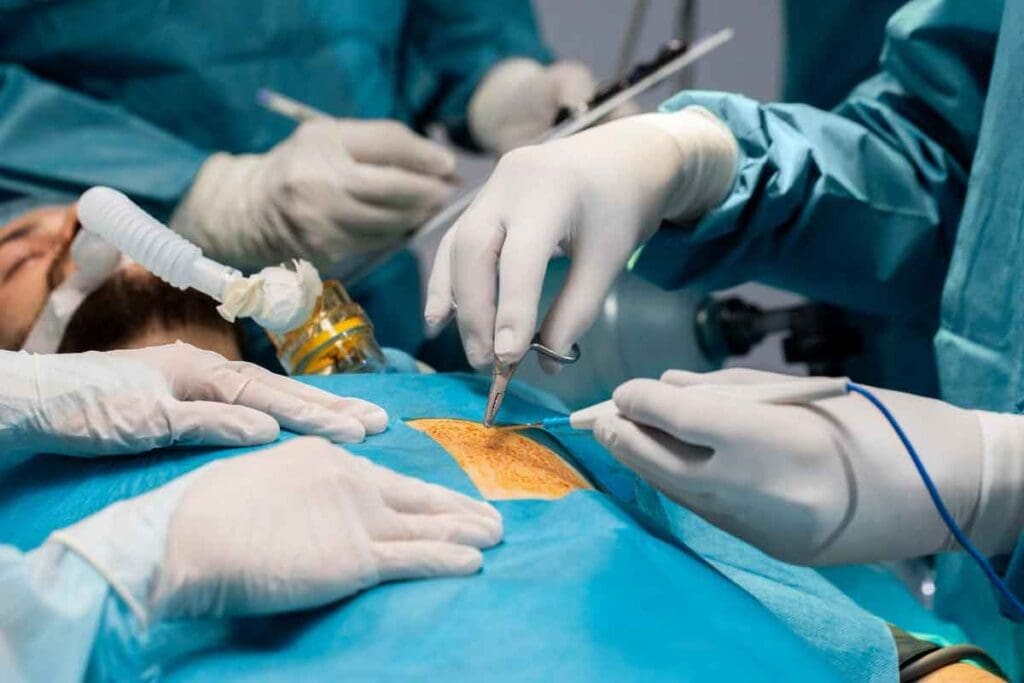Last Updated on November 26, 2025 by Bilal Hasdemir

Ablation is a medical procedure that treats irregular heart rhythms, known as atrial fibrillation (AFib). It involves destroying or scarring the heart tissue that triggers abnormal electrical impulses. Learn what is ablation, how it treats atrial fibrillation (AFib), procedure steps, and expected outcomes.
Catheter ablation for atrial fibrillation is a minimally invasive procedure. A doctor uses catheters to create scars in the heart. This stops the irregular heartbeats. It’s a big help for those with AFib.
Liv Hospital combines trust, innovation, and expertise for AFib treatment. Their focus on patients ensures they get relief from AFib symptoms.
Key Takeaways
- Ablation treats irregular heart rhythms by destroying or scarring heart tissue.
- Catheter ablation is a minimally invasive procedure for AFib treatment.
- Liv Hospital offers advanced AFib treatment through ablation procedures.
- The procedure involves creating scars in the heart to stop irregular heartbeats.
- Patient-focused care is a priority at Liv Hospital.
Understanding What Is A B L A T I O N and Its Role in Cardiac Care

The term “ablation” is often linked with heart care. But what does it mean in medical terms? Cardiac ablation is a method that uses energy to destroy or scar a small part of the heart. This part is causing abnormal heart rhythms.
Definition and Basic Principles of Cardiac Ablation
Cardiac ablation uses energy, like radiofrequency or extreme cold, to create lesions in the heart. These lesions stop abnormal electrical signals that cause arrhythmias. This helps restore a normal heart rhythm. says it’s often used for atrial fibrillation, a condition with rapid and irregular heartbeats.
The procedure uses catheters, thin, flexible tubes inserted through a vein in the leg. These tubes lead to the heart. They deliver the energy needed to create the lesions.
Common Terminology and Misspellings
The term “ablation” is sometimes misspelled as “abolation,” “anlation,” or “abblation.” These misspellings are not recognized medical terms and can lead to confusion. It’s essential to use the correct terminology when discussing cardiac ablation to ensure clarity and accuracy.
Historical Development of Ablation Techniques
Cardiac ablation has seen a lot of progress over the years. At first, it involved more invasive surgical techniques. Thanks to technology, we now have catheter-based ablation. This makes the procedure less invasive and more effective.
| Technique | Description | Advantages |
| Radiofrequency Ablation | Uses heat to create lesions | Effective for treating various arrhythmias |
| Cryoablation | Uses extreme cold to create lesions | Less risk of damaging surrounding tissue |
Understanding the evolution and current state of cardiac ablation techniques is key. As technology advances, we can expect better and safer ablation procedures.
Atrial Fibrillation: Causes, Symptoms, and Impact on Health

Atrial fibrillation (AFib) is a heart condition where the heart beats irregularly and fast. It happens when the upper heart chambers (atria) don’t beat in sync with the lower chambers (ventricles).
Doctors can find AFib during a routine checkup. They use tests like blood tests, electrocardiogram (ECG or EKG), and echocardiogram to confirm it.
The Mechanism of AFib and Abnormal Heart Rhythms
AFib is caused by abnormal electrical pathways in the heart. Normally, the heart’s rhythm is controlled by a precise electrical system. But in AFib, this system gets disrupted, causing irregular heartbeats.
Key factors contributing to AFib include:
- Age
- High blood pressure
- Heart disease
- Obesity
- Diabetes
How AFib Affects Quality of Life and Long-term Health
AFib can greatly affect a person’s life, causing symptoms like palpitations and shortness of breath. If not treated, it can lead to serious problems like stroke and heart failure.
Effective management of AFib is key to improving health. Treatments like heart ablation can help manage symptoms and enhance quality of life.
Heart Ablation for Atrial Fibrillation: The Fundamental Approach
Heart ablation for atrial fibrillation is a treatment that aims to restore a normal heart rhythm. It targets the heart’s abnormal electrical pathways. This method is key for those with atrial fibrillation (AFib) who don’t get better with medicine or other treatments.
Ablation for AFib uses energy to destroy the heart tissue, causing the irregular rhythm. The main goal is to eliminate the source of the arrhythmia and bring back a normal heart rhythm.
How Ablation Targets Electrical Pathways in AFib
Ablation focuses on the heart’s electrical pathways that lead to AFib’s abnormal rhythms. The process includes:
- Finding the heart areas causing the arrhythmia
- Using energy (heat or cold) to destroy these pathways
- Bringing back a normal heart rhythm
The success of ablation relies on finding and targeting the heart areas causing AFib. Advanced mapping helps locate the abnormal electrical pathways and guides the procedure.
Different Types of Ablation Techniques for AFib
Several ablation techniques are used to treat AFib, including:
- Radiofrequency Ablation: uses heat to destroy the abnormal pathways
- Cryoablation: uses extreme cold to freeze the abnormal tissue
- Emerging technologies: include new energy sources and techniques to improvethes effectiveness and safety
Each ablation technique has its own benefits. The choice depends on the patient’s condition and their AFib specifics.
The Ablation Procedure: What to Expect During Surgery for Atrial Fibrillation
Getting an ablation procedure for atrial fibrillation is a big step for heart health. This treatment is done to fix irregular heartbeats caused by atrial fibrillation. It’s a minimally invasive method.
Pre-Procedure Preparation and Evaluation
Before the ablation procedure, a detailed check is done to see if you’re a good candidate. This includes looking at your medical history, current meds, and past treatments for atrial fibrillation.
- Patients usually have to stop certain meds before the procedure.
- A pre-procedure check might include blood tests, an ECG, and sometimes a TEE.
- Patients get told about fasting and other prep steps.
Step-by-Step Walkthrough of Catheter Ablation
The catheter ablation process has several steps:
- An IV line is put in for anesthesia and other meds.
- A small puncture is made in the groin area to access a blood vessel.
- A catheter is guided through the blood vessel to the heart, using imaging to place it correctly.
- The catheter then sends energy (radiofrequency or cryoablation) to the heart, making lesions to block bad electrical paths.
Immediate Post-Procedure Care
After the ablation procedure, patients are watched in a recovery area for a few hours. Medical staff will:
- Keep an eye on vital signs and look for any complications.
- Manage any pain or discomfort.
- Give instructions on post-procedure care, like meds and follow-up visits.
Knowing what happens during and after surgery for atrial fibrillation can ease worries. It helps prepare patients for the recovery.
Types of Ablation Techniques for Treating AFib
AFib ablation offers many treatment options. The right technique depends on the patient’s health, AFib severity, and heart disease.
Radiofrequency Ablation: Process and Applications
Radiofrequency ablation is a common treatment for AFib. It uses catheters to send radiofrequency energy to the heart. This energy creates lesions that stop abnormal electrical pathways.
The process starts with tests to find the heart areas causing arrhythmia. The patient is sedated to reduce pain during the procedure.
Cryoablation: Freezing Abnormal Pathways
Cryoablation, or cryotherapy, is another effective treatment. It freezes the heart’s abnormal electrical pathways. This helps restore a normal heart rhythm.
Cryoablation is chosen for its precision and lower risk of heart damage. It involves inserting catheters with cryotherapy probes into the heart, guided by imaging.
Emerging Ablation Technologies and Approaches
The field of AFib ablation is growing, with new technologies emerging. These include pulsed field ablation and laser ablation. They promise to create precise lesions with less damage to surrounding tissue.
| Ablation Technique | Key Features | Benefits |
| Radiofrequency Ablation | Uses radiofrequency energy to create lesions | Effective for many patients, widely available |
| Cryoablation | Employs extreme cold to freeze abnormal pathways | Precise, reduced risk of tissue damage |
| Pulsed Field Ablation | Creates lesions using pulsed electrical fields | Minimally invasive, precise |
Effectiveness of Ablation for Atrial Fibrillation
Studies show that ablation can be a good treatment for atrial fibrillation. The success rate depends on the type of AFib. Catheter ablation works well for patients with paroxysmal AFib by isolating pulmonary veins.
Success Rates for Different Types of AFib
The success of ablation changes with the type of atrial fibrillation. For paroxysmal AFib, where episodes are not constant, catheter ablation works well. It can help 60-80 percent of patients stay free from AFib long-term.
For persistent AFib, success rates are lower. But new techniques in ablation are making things better. The success of the procedure also depends on the type of AFib, how long it lasts, and any heart disease.
Can Ablation Cure Atrial Fibrillation Permanently?
Many patients wonder if ablation can cure atrial fibrillation for good. While it can greatly reduce or stop AFib symptoms, calling it a “cure” is careful. Success depends on the type and length of AFib, and the patient’s health.
For paroxysmal AFib, ablation often means long-term relief. But some might need more treatments or another procedure.
Factors Affecting Treatment Success
Many things can change how well ablation works for atrial fibrillation. These include:
- Type and Duration of AFib: Paroxysmal AFib usually has better results than persistent or long-standing AFib.
- Underlying Heart Disease: Conditions like heart failure or coronary artery disease can impact success.
- Patient Age and Overall Health: Younger patients with fewer health problems tend to do better.
- Operator Experience: The skill and experience of the doctor doing the procedure also matters a lot.
Knowing these factors helps set realistic hopes and make better choices about ablation therapy.
Are Ablations Dangerous? Understanding the Risks and Complications
Patients need to know the risks of ablation for atrial fibrillation. Ablation is usually safe, but there are possible risks and complications. Knowing these can help patients make informed decisions.
Common Side Effects and Minor Complications
Most people have some side effects after ablation for atrial fibrillation. These are often minor and short-lived. They might feel pain or discomfort where the catheter was inserted, temporary arrhythmias, or feel tired. Some might also see swelling or bruising at the site.
Serious Risks Associated with Ablation Heart Surgery
Even though rare, serious problems can happen with ablation for atrial fibrillation. These include cardiac tamponade (fluid around the heart), stroke, and pulmonary vein stenosis (narrowing of the veins). There’s also a chance of infection and bleeding, like with any invasive procedure.
Risk Factors That May Increase Complication Rates
Some factors can make complications more likely during or after ablation for atrial fibrillation. These include being older, having other heart diseases, or having had heart surgeries before. The table below lists some key risk factors and their possible effects on complication rates.
| Risk Factor | Potential Impact |
| Older Age | Increased risk of bleeding and stroke |
| Presence of Other Heart Diseases | Higher risk of complications during the procedure |
| History of Previous Heart Surgeries | Increased complexity and risk of the ablation procedure |
Patients need to talk to their healthcare provider about their individual risks. This way, they can understand the possible benefits and risks of ablation for their specific situation.
Alternative Treatments and When to Consider Ablation for AFib
When you’re diagnosed with atrial fibrillation (AFib), you might look into different treatments. Managing AFib involves many therapies, each chosen based on your health and medical history.
Medication Management for Atrial Fibrillation
Medicine is often the first step in treating AFib. Doctors might prescribe beta blockers and calcium channel blockers to control your heart rate. Blood thinners are also used to prevent strokes. Effective medication management can greatly improve your quality.
The right medication depends on your health, how severe your AFib is, and other factors. For example, beta blockers help slow your heart rate. Anticoagulants are key to lowering stroke risk.
| Medication Type | Purpose | Examples |
| Beta Blockers | Control heart rate | Metoprolol, Propranolol |
| Calcium Channel Blockers | Control heart rate | Diltiazem, Verapamil |
| Anticoagulants | Prevent stroke | Warfarin, Apixaban |
Cardioversion and Other Non-Ablation Procedures
For some, cardioversion might be suggested. This procedure uses a controlled electric shock to restore a normal heart rhythm. It’s often effective for those with persistent AFib.
“Cardioversion is a valuable treatment option for patients with atrial fibrillation, giving them a chance to regain normal heart rhythm.” – Expert Cardiologist
Other non-ablation methods include lifestyle changes and alternative therapies. Making lifestyle adjustments like losing weight, exercising, and changing your diet can help manage AFib.
Ideal Candidates for Ablation Therapy
Ablation therapy is considered for those who haven’t responded to medication or other treatments. Ideal candidates for ablation are usually those with symptomatic AFib who can’t tolerate or haven’t responded to medical therapy.
Choosing ablation involves a detailed evaluation of your condition, including the type and duration of AFib, your overall health, and previous treatments.
In conclusion, while ablation is a valuable option for AFib, it’s not the only one. Patients and doctors must consider the benefits and risks of different treatments to find the best approach.
Conclusion: Is Ablation Right for Your AFib Treatment?
Ablation is a treatment option for atrial fibrillation. But it’s important to think about your own situation. The severity of AFib, your health, and what you prefer are key in choosing the best treatment.
When looking at ablation for atrial fibrillation, consider the good and bad sides. Talk to your doctor about your specific case. This will help decide if ablation is the best choice for you.
Choosing afib treatment options is a big decision. Knowing about the procedure, risks, and possible results helps. This way, you can decide if ablation is right for AFIB treatment.
In the end, choosing ablation should be a careful thought. It’s best to talk it over with a healthcare professional. They can help you make the right choice for your situation.
FAQ
What is ablation for atrial fibrillation?
Ablation for atrial fibrillation is a medical procedure. It uses energy to destroy or scar the abnormal electrical pathways in the heart. These pathways cause AFib.
How does ablation treat atrial fibrillation?
Ablation treats atrial fibrillation by targeting and eliminating the abnormal electrical pathways. This restores a normal heart rhythm.
What are the different types of ablation techniques used to treat AFib?
There are different types of ablation techniques for treating AFib. These include radiofrequency ablation, cryoablation, and emerging technologies like laser ablation.
Is ablation a cure for atrial fibrillation?
Ablation can be an effective treatment for atrial fibrillation. But whether it is a cure depends on individual factors. These include the type and severity of AFib.
What are the risks and complications associated with ablation?
Ablation can have risks and complications. These include common side effects like bruising and bleeding. Serious risks include cardiac tamponade and stroke.
How effective is ablation in treating atrial fibrillation?
The effectiveness of ablation in treating atrial fibrillation varies. It depends on factors like the type and severity of AFib. Success rates range from 50% to 80%.
What is the difference between radiofrequency ablation and cryoablation?
Radiofrequency ablation uses heat to destroy abnormal electrical pathways. Cryoablation uses extreme cold to freeze and eliminate the abnormal tissue.
Are there alternative treatments for atrial fibrillation besides ablation?
Yes, there are alternative treatments for atrial fibrillation. These include medication management, cardioversion, and other non-ablation procedures.
How do I know if I’m a candidate for ablation therapy?
Ideal candidates for ablation therapy are those with symptomatic AFib. They should not have responded to other treatments or had significant symptoms.
What should I expect during the ablation procedure?
During the ablation procedure, you can expect pre-procedure preparation. You will also undergo a step-by-step catheter ablation process. Immediate post-procedure care is also provided.
Can ablation cure atrial fibrillation permanently?
Ablation can be effective in treating atrial fibrillation. But the likelihood of a permanent cure depends on individual factors. These include the type and severity of AFib.
What are the emerging ablation technologies and approaches?
Emerging ablation technologies include new energy sources like laser and ultrasound. There are also advancements in catheter design and navigation systems.
References
Hindricks, G., Potpara, T., Dagres, N., Arbelo, E., Bax, J. J., Blomström-Lundqvist, C., Boriani, G., Castella, M., Dan, G. A., Dilaveris, P. E., Fauchier, L., Filippatos, G., Kalman, J. M., La Meir, M., Lane, D. A., Lebeau, J. P., Lettino, M., Lip, G. Y. H., Pinto, F. J., … ESC Scientific Document Group. (2021). 2020 ESC Guidelines for the diagnosis and management of atrial fibrillation developed in collaboration with the European Association for Cardio-Thoracic Surgery (EACTS). European Heart Journal, 42(5), 373–498. https://www.ncbi.nlm.nih.gov/pmc/articles/PMC7851953/






